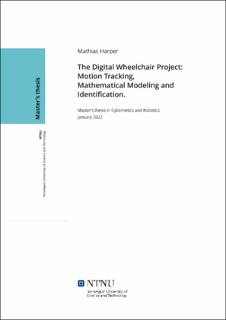| dc.contributor.advisor | Varagnolo, Damiano | |
| dc.contributor.advisor | Doshmanziari, Roya | |
| dc.contributor.author | Harper, Mathias | |
| dc.date.accessioned | 2022-11-19T18:19:35Z | |
| dc.date.available | 2022-11-19T18:19:35Z | |
| dc.date.issued | 2022 | |
| dc.identifier | no.ntnu:inspera:102231297:37620716 | |
| dc.identifier.uri | https://hdl.handle.net/11250/3032986 | |
| dc.description.abstract | Mange rullestolbrukere lever en fysisk inaktiv livsstil på grunn av begrensede bevegelsesmuligheter og generelle funksjonshemminger. Denne mangelen på fysisk aktivitet kan ha alvorlige implikasjoner på både deres fysiske og mentale helse. I denne oppgaven undersøker vi mulighetene for å estimere energiforbruket og hjertefrekvensen hos rullestolbrukere ved å bruke bevegelsesbanene til armene deres under trening.
To modeller ble utledet med hensikten å parameterisere bevegelsen til deltakerne i studiet, en modell basert på det doble pendelet og en modell basert på Van der pol-oscillatoren. Parametrene ble så regnet ut ved bruk av minste kvadraters estimering og derivatfri optimalisering. Videre ble de estimerte parametrenes korrelasjon til energiforbruk, hjertefrekvens og andre demografiske variabler undersøkt.
Resultatene viser at den doble pendelmodellen yter dårlig, og dens estimerte parametere viser ingen korrelasjon til energiforbruk eller hjertefrekvens. Van der pol-modellen viser mer lovende resultater, siden det under spesifikke omstendigheter ble observert korrelasjoner mellom de estimerte parametrene og energiforbruk og hjertefrekvens. | |
| dc.description.abstract | Many wheelchair users lead physically inactive lifestyles due to limited movement options and overall disabilities. This lack of physical activity may seriously affect their physical and mental conditions. In this thesis, we investigate the possibilities of estimating the energy expenditure and physical activity in wheelchair users using their motion-captured trajectories during exercise.
Two models were derived with the intent to parameterize the movement of the participants in the study, a model based on the double pendulum and a model based on the Van der pol oscillator. The parameters were later determined using least squares estimation and derivative-free optimization in order analyze their correlation to energy expenditure, heart rate, and other demographic variables.
The results show that the double pendulum model performs poorly, and its estimated parameters show no correlation to energy expenditure or heart rate. On the other hand, the van der pol model shows some promise, as, under specific circumstances, correlations between energy expenditure and heart rate were observed. | |
| dc.language | eng | |
| dc.publisher | NTNU | |
| dc.title | The Digital Wheelchair Project: Motion Tracking, Mathematical Modeling and Identification. | |
| dc.type | Master thesis | |
